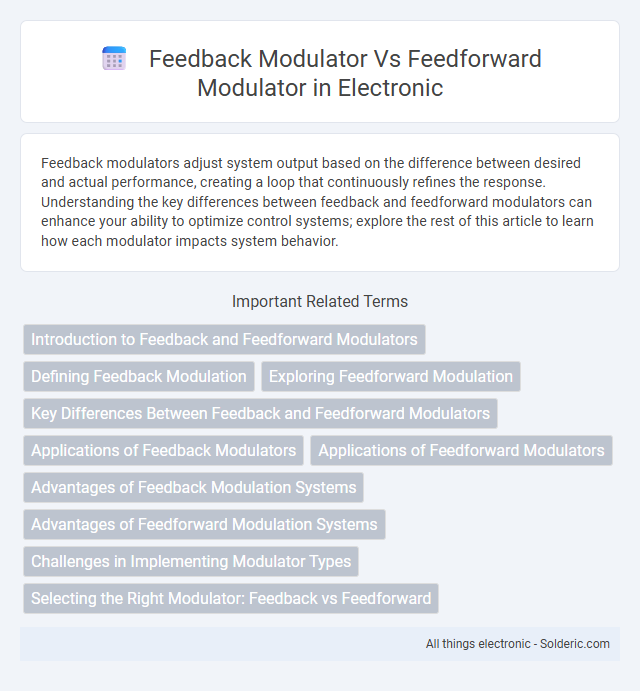Feedback modulators adjust system output based on the difference between desired and actual performance, creating a loop that continuously refines the response. Understanding the key differences between feedback and feedforward modulators can enhance your ability to optimize control systems; explore the rest of this article to learn how each modulator impacts system behavior.
Comparison Table
| Aspect | Feedback Modulator | Feedforward Modulator |
|---|---|---|
| Function | Adjusts output based on error correction from the output | Modifies input signal proactively before processing |
| Signal Path | Uses output signals for modulation | Uses input signals for modulation |
| Response Speed | Slower due to feedback loop delay | Faster as modulation happens in advance |
| Stability | Can cause instability if improperly designed | Generally more stable |
| Application | Used in systems requiring error correction like amplifiers | Used in noise cancellation and predictive controls |
| Complexity | More complex due to feedback loop management | Less complex, straightforward signal handling |
Introduction to Feedback and Feedforward Modulators
Feedback modulators adjust signals by continuously comparing output with input, enabling dynamic correction and system stability in applications like adaptive control and noise cancellation. Feedforward modulators predict system behavior by processing input signals ahead of time, offering rapid response and minimizing delay in control systems and communication networks. Both modulators optimize signal processing but differ in their approach--feedback relies on real-time error correction, while feedforward depends on preemptive adjustment based on input analysis.
Defining Feedback Modulation
Feedback modulation involves adjusting a system's output based on the comparison between the actual output and the desired outcome, enabling real-time error correction. Unlike feedforward modulation, which anticipates changes without relying on output feedback, feedback modulators continuously refine performance through sensor input or signal monitoring. Your choice between these modulators depends on the need for accuracy, stability, and dynamic response in control systems.
Exploring Feedforward Modulation
Feedforward modulation involves adjusting signals in anticipation of changes, enhancing system responsiveness by processing input before the output is affected. This approach reduces latency and improves stability in control systems by preemptively modulating the signal based on expected disturbances or reference inputs. Feedforward modulation is widely applied in neural circuits, audio processing, and adaptive control systems to optimize performance without relying solely on feedback correction.
Key Differences Between Feedback and Feedforward Modulators
Feedback modulators adjust system output by comparing it with a reference signal and correcting errors, ensuring stability and reduced distortion, commonly used in control systems and amplifiers. Feedforward modulators, on the other hand, predict disturbances or input changes in advance and compensate proactively, enhancing response speed and accuracy in applications like communication systems and signal processing. The key differences lie in feedback involving error correction through output monitoring, whereas feedforward depends on input measurement for preemptive adjustment, impacting system stability and transient response.
Applications of Feedback Modulators
Feedback modulators are extensively used in communication systems to enhance signal stability and reduce distortion by continuously adjusting the output based on the input signal. They are crucial in phase-locked loops (PLLs) for frequency synthesis, enabling precise frequency control in radio transmitters and receivers. Feedback modulators also improve the performance of delta-sigma analog-to-digital converters by shaping quantization noise and increasing resolution.
Applications of Feedforward Modulators
Feedforward modulators are widely used in communication systems to preemptively correct signal distortions and improve transmission quality, particularly in radio frequency (RF) power amplifiers and optical communication links. They enable precise phase and amplitude adjustments by processing the input signal before amplification, which minimizes nonlinear distortions and enhances overall linearity. Industrial applications include satellite transponders, radar systems, and high-speed digital communications where maintaining signal integrity is critical.
Advantages of Feedback Modulation Systems
Feedback modulation systems offer improved stability and accuracy by continuously comparing output signals with input references, enabling real-time error correction. These systems enhance noise immunity and reduce distortion, resulting in higher signal fidelity in communication and control applications. Their adaptive nature allows dynamic response adjustments to varying signal conditions, optimizing overall system performance.
Advantages of Feedforward Modulation Systems
Feedforward modulation systems offer improved signal accuracy by predicting and compensating for disturbances before they affect the output, resulting in faster response times compared to feedback systems. These systems reduce the risk of instability and oscillations since they do not rely on error correction loops. Enhanced performance in dynamic environments makes feedforward modulation ideal for applications requiring precise control and minimal latency.
Challenges in Implementing Modulator Types
Feedback modulators face challenges such as stability issues and sensitivity to component variations, requiring complex design to maintain accurate signal processing. Feedforward modulators demand precise matching between the feedforward path and the main signal path, making them difficult to implement due to the need for high bandwidth and low latency. Optimizing your system's performance involves carefully addressing these challenges to ensure reliable and efficient modulation.
Selecting the Right Modulator: Feedback vs Feedforward
Selecting the right modulator depends on your system's stability and response requirements. Feedback modulators provide improved accuracy and noise reduction by continuously correcting output errors, making them ideal for systems needing high precision under varying conditions. Feedforward modulators, on the other hand, anticipate disturbances and adjust control signals in advance, offering faster response times useful in applications demanding rapid adaptation without the complexity of error correction loops.
Feedback modulator vs feedforward modulator Infographic

 solderic.com
solderic.com